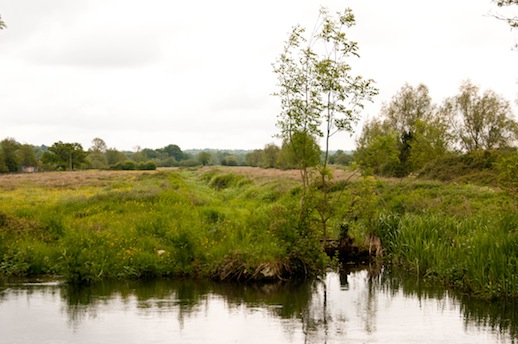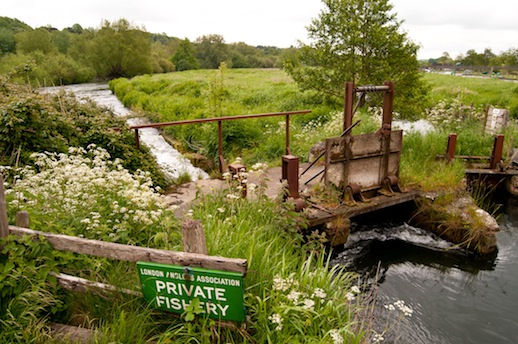The importance of water meadows. By Danny Adcock.
In his excellent book The History of the Countryside, Oliver Rackham describes four ways in which we lose our landscape: the loss of beauty, of freedom, of wildlife and vegetation, and of meaning. There’s also a fifth way in which we can lose our landscape: by forgetting.
Water meadows – true water meadows that is – were found alongside many rivers in England, but it was the chalk rivers of the South that lent their unique qualities particularly well to the creation of what has been called the pinnacle of intensive farming before the industrial revolution. In a historical context intensive is a term which, when compared to the mechanised, economically driven farming that holds sway over much of our countryside today, rather pales into insignificance. True water meadows were not just meadows alongside rivers that were flooded in times of high flows, but meadows that were purposely flooded or drowned – the men carrying out the flooding were called drowners – using an artificially dug channels. They ranged from simple gravity fed systems to a complex plexus of sluices, hatches, drains, mains, carriers and channels. The idea was not to flood the meadows with standing water which would kill the grasses, but to have a constant stream or trickle of water flowing into, across and then out of the meadow. By drowning at particular times of year, and preventing frosts, Spring growth on a water meadow occurred earlier. Livestock would benefit from the ‘early bite,’ and a harvestable hay crop also occurred earlier.
One Rowland Vaughan, in 1610, claimed to have invented the water meadow system after seeing how much earlier and lusher grass had grown where a mole had burrowed through a river bank. Charles Rangeley-Wilson writes about Vaughan and in his latest book Silt Road. Though it was the seventeenth century that saw the proliferation of the water meadows, we know that humans have been utilising rivers and their flows for irrigation and drainage purposes since our transformation from hunter-gatherers thousands of years ago; civilisations across the globe have prospered as a result of taming water: the Egyptians, the Romans, the Maya; all had systems of irrigation, and according to Oliver Rackham irrigated meadows were in use from ancient times in parts of Europe.
Today water meadows are little known. Their historical and cultural part in our landscape has faded into disuse, like the meadows themselves, apart from in a very few places. Some of the best known are the Harnham water meadows which lie to the south west of Salisbury Cathedral, and are now owned by The Harnham Water Meadows Trust, and the Dean and Chapter of Salisbury Cathedral. They are fed by two arms of the river Nadder reaching out as if in supplication to the cathedral lying beyond; the Nadder then drains into that most famous of chalk streams the Avon. Following the Avon south into Hampshire water meadows bordered, and fed from it, at Britford, down through Bodenham, Charlton All Saints, Downton, Burgate, Fordingbridge and on. In places they are still drowned to some extent. There are also water meadows still cared for on the Thame near Oxford by the Hurst Water Meadow Trust.
At Upper Britford, which I visited this Spring, the London Angling Association has a wonderful fishery on the Avon. The water meadows there were extensive, and the fishery bailiff still controls the levels between the original river channel, and two man-made ones using hatches and sluices as he has for the last twenty five years; apart from last year that is when ‘The whole place was under water anyway.’ Most of the mains and carriers are disused, furred up with reeds and rushes that have established themselves now there’s not as much maintenance. I saw several water voles which find the artificial channels much more to their liking than the swift flows of the river-proper; innumerable tadpoles blackened the channel- bottoms in aquatic murmurations, and the panes between channels and old mains and drains were spread butter-yellow with wild flowers. In places coppiced and pollarded trees are further evidence of how the landscape was used but not, as so often today, abused. Meadows are also still in use to an extent at Lower Burgate, and on the Somerley Estate at Ellingham.
Most would probably believe the remaining water meadows are an anachronism of agriculture and landscape. True water meadows have slipped from our consciousness, and at some point in the not too distant future the working water meadow will be gone from living memory. Water meadows are not unique in this respect; many aspects of our landscape, of how we lived in the landscape, are being forgotten. But by forgetting our past, forgetting how our landscape worked, and how we worked in and with our landscape, we are becoming detached from our place in our present landscape. Advocating a large scale return to outdated agricultural practices is not the way forward, but there is a lot to learn from the past. Water meadow technology used the river’s water, but it was technology that borrowed from the river, the landscape and from nature, not took; that worked with what nature had to provide. The physical remains of water meadows have an environmental and historical significance. Most of them may now be mere lumps, bumps and rusted bits of ironwork, but they’re lumps, bumps and rusted bits of ironwork from the history of our working countryside; they have as much to tell us as a stately home, and maybe more to tell us about how we should be treating our countryside today.

